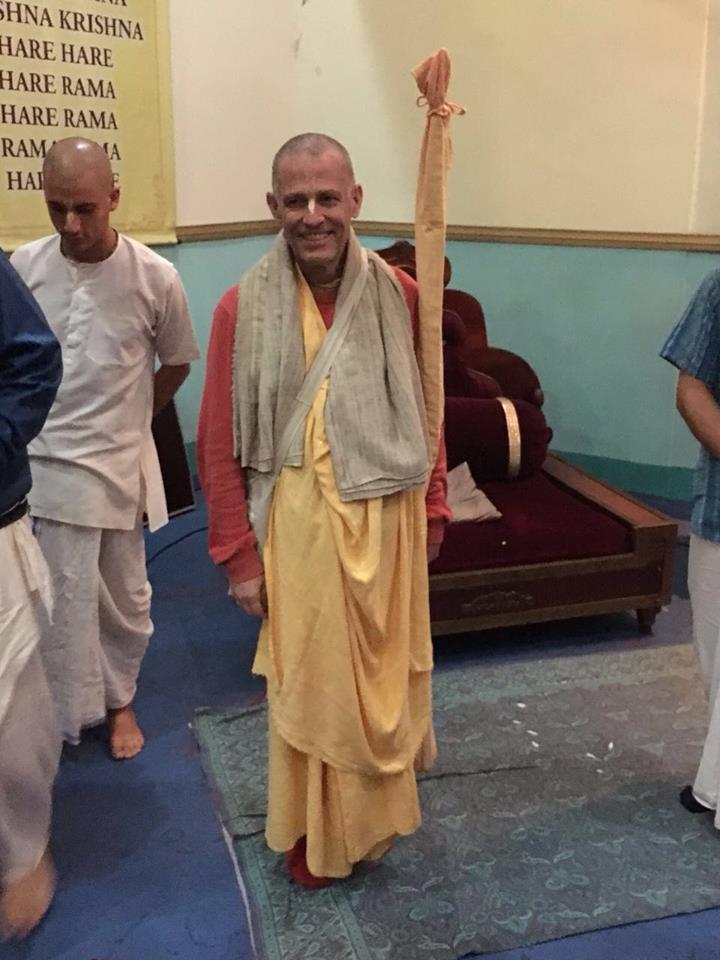Considering the Cleanliness of Cotton
This wanderer of fields sometimes gets approached by a questioner on matters of concern for pūjārīs—the unsung heroes and heroines of arcana, the service of God in his arcā-mūrti or form that receives formal worship. Generally I like to avoid arcana questions, because they tend to be inherently unanswerable to everyone’s satisfaction. To illustrate:
Today’s question was about cotton clothes the pūjārī wears while performing arcana activities. As cleanliness and purity are at a premium in this culture (even if moderns would likely scorn such practices as obsessive, evidence for, or productive of, neurosis), the question is whether or not cotton clothes that have been worn once “on the altar” can be worn again the next day for altar service. Strictly speaking, it seems, according to scriptural prescriptions (of which there are countless, about such matters), it would not be permitted: Cotton, unlike silk, is not purified by hanging up and letting the breeze blow through it; rather, it must be washed in water.
The Problem, my questioner explains, is that in this pūjārī’s temple’s geographical location, the climate is such that the drying of clothes can take more than one day, due to humidity and cold.
And so, one asks, could an exception be made, considering the unyielding realities of climate, and presuming that the pious compilers of pūjā manuals, no doubt harking from Bharatavarṣa, would not have anticipated the problem in northern climes?

The questioner reports that one has been told (by a senior, respected pūjārī), that no, no exception can be made in this regard, as it is Krishna’s standard of cleanliness: as the Lord bathes and puts on fresh cloth every day, so the pūjārīs must do the same.
Like many questions about right practices in bhakti, a useful starting point for arriving at a conclusion on this cotton conundrum could be to try to distinguish principles from details (even though we know that it often happens that one Vaiṣṇava’s principle is another’s detail, and vice-versa).
The argument that Krishna’s standard of cleanliness for himself sets the standard for the pūjārī’s standard of cleanliness could be seen as reflecting the broad Vedic (or perhaps more specifically tantric) ritual principle that “to worship the gods, one must become (like) a god” (sorry, no reference at hand for this—maybe Lakṣmī Tantra and other, Pāñcarātrika texts). Here, some notion of becoming like—in some sense equal to—that which, or whom, one worships, seems to be invoked.
One might, however, protest, that Krishna always wears silk cloth, not cotton, and aside from the question whether his silk clothing gets aired after each wearing, unlike cotton cloth, it seems to be regarded as remaining pure, even though silk mūrti-vastra is never washed (as it would ruin the delicate jārī work, etc.). And let’s not open another potentially troublesome question: Is the silk we offer Krishna ahiṁsa silk, and if not, is Krishna actually pleased to accept it, though its production involves the killing of countless silkworms?! And we could keep going: Under what conditions of human maltreatment (e.g. unfairly low payment) was the cotton of our clothing grown and harvested; and what sort of chemical treatment—pesticides and fertilizers—were involved in the cotton production?
Incidently, the solution to the issue of mūrti silk possibly not being so pure after all (but not addressing the ahiṁsa question) seems to have been found by the priests of the Śrīnāthjī temple in Nathadwar, Rajasthan: A completely new outfit for Krishna is sewn and offered EVERY DAY. Hmmm, well, there’s a nice standard (actually Śrīnāthjī’s outfits are quite simple). A standard to work toward, perhaps.
Okay, what other principle might be at issue here in the clean cotton question? Of course, one says generally that cleanliness or purity is a principle in arcana, and more broadly, in the practice of bhakti. Aside from Krishna being the “supreme pure”, cleanliness is an aspect of cultivating the “mode of goodness” (sattva-guṇa) which, in turn, is conducive to becoming elevated to “pure goodness” (śuddha-sattva), the level of consciousness in which the activities of pure bhakti are enacted. So now we are talking about the spiritual advancement of the person practicing bhakti. It is in his or her interest to be “fixed” in sattva-guṇa to make steady spiritual progress. Clear enough.
Anything more? At least one other principle might be considered, and that is constancy of service. Indeed, when a question arose about women’s monthly period in relation to purity in mūrti-sevā, Srila Prabhupada placed constancy of service as the superior principle: the service to the Lord must continue non-stop, even if this is done in a “contaminated” state. And Prabhupada went on to write that this is the “Goswami system” (I don’t have the exact quote at hand), in contrast to that of the smārtas.

But how does this relate with cotton cloth? The point here would be that if it is a struggle to wash and dry cotton cloth daily, this could easily bring a loss of enthusiasm for sevā, which eventually leads to devotees giving up the service. Then the struggle becomes one of finding a devotee willing to do the service (at least willing, if not eager), since the arcana service in temples must continue without interruption. Related to this principle would seem to be Rūpa Gosvāmī’s principle (Upadeśāmṛta) that “over-endeavor” (prayāsa) can damage bhakti. Also damaging to bhakti, Rūpa Gosvāmī says in the same verse, is either over-doing or under-doing the practice of regulations (niyama āgraha / niyama agraha = niyamāgraha). Well, great, but who decides what is over- or under-doing of regulations? Are we back where we started?
This wandering monk’s conclusion: These are all important principles in bhakti, and more specifically in arcana. AND, the principles have to be balanced, or weighed, against, or with, each other. Especially important, it seems to me, is steadiness in service and enthusiasm in service. Arcana, Prabhupada once said (London 1973 Radha-Gokulananda installation, maybe?) should not become a burden around the neck (actually his point was, as I remember, that unless sevakas regularly hear about Krishna’s glories etc., the worship will become burdensome). Only if pūjārīs are happy in their service can we expect others in the Vaiṣṇava community to feel happiness in seeing the Lord and seeing him being worshipped; and only then can we hope that others will become attracted to Krishna, by meeting with happy devotees who like to go out and invite people to come and see the Lord in his temple, how he is (happily, devotionally, not obsessively) worshipped.
All nice abstract points, but what about daily cotton washing and drying? One solution would be to get all-(ahiṁsa-)silk cloth for use on the altar. This was always my solution when I was a regular pūjārī (back in ancient times, the 70s and early 80s). Yes, it is more expensive, but perhaps it is worth it to save up for.
Otherwise, I would say go ahead and use the cotton cloth twice instead of once, on successive days, maybe hanging it up nicely in between use, and spraying it with a very light spray of water (like from a sprayer for ironing cloth or for Tulasī), as a symbolic “washing” (you will laugh, but so much of Vedic ritual is about finding acceptable substitutions for items or actions not available or possible).
Third solution: Will someone please find (or compose) a mantra for purifying cotton cloth?!
There is sure to be a lingering doubt: WHY must cotton be washed with water, while silk (at least for 2-3 days) can be purified with air? This question might have to remain a mystery. Śāstra can be like that—making cold declarations unbraced by any explanations. Ask an Indian pūjārī why this difference between cotton and silk, and he is likely to say, “Because that’s how it is. That’s what it says in śāstra!”